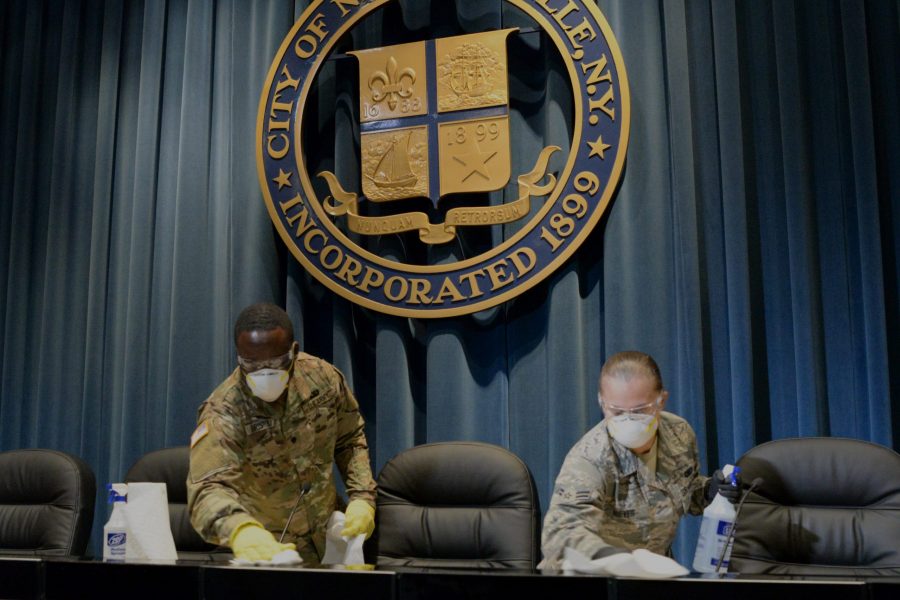A total of 670 National Guard members from 15 states have been activated as of the morning of March 16 in support of their states’ responses to the COVID-19 pandemic, according to the National Guard Bureau.
Any state that declares a state of emergency is authorized to call up its state’s Guard troops, according to an NGB release.
Air and Army Guardsmen are supporting the following COVID-19 missions:
- Drive-through testing facilities
- Response liaisons and support to state Emergency Operations Centers
- Support to healthcare professionals
- Logistics support
- Assisting with disinfecting/cleaning of common public spaces
- Providing transportation support for health care providers
- Collecting and delivering samples
- Assisting with sample administration.
The New York National Guard has the largest number of personnel activated so far, with 516 of its citizen Airmen and Soldiers helping. In addition to the support missions listed above, New York Guardsmen also are helping to get food to families whose children lost access to school lunches due to pandemic-related closures, according to Eric Durr, director of public affairs at the New York State Division of Military and Naval Affairs.
As of March 16, approximately 20 percent, or 112, of these responding personnel came from the New York Air National Guard, Col. Richard Goldenberg, a division spokesman, told Air Force Magazine.
“The area currently affected is predominantly the Lower Hudson Valley, Westchester County, and Long Island,” he said. “That is home to the 105th Airlift Wing and the 106th Rescue Wing.”
Goldenberg declined to confirm whether there were any confirmed cases of COVID-19 among its troops, or to provide any data on possible presumptive positive cases (which the Centers for Disease Control and Prevention define as ones in which “at least one respiratory specimen…tested positive for the virus that causes COVID-19 at a state or local laboratory”), citing privacy concerns.
However, he said “there are members that are not currently available to us for military service, due to the precautions taken by the State Department of Health.”
“In order to protect the privacy of our members, we’re not gonna release the specific numbers of those that we have either out of an abundance of caution quarantined or anyone else in amongst our force that are complying with local department of health requirements, so it would be no different if it was a fireman, a school teacher, or anyone else,” he said. “Their numbers are being reflected in the state’s numbers.”
The Colorado National Guard has the second-highest number of troops activated in the fight against COVID-19, with 145 personnel helping “state agencies with medical support and logistics at drive-up COVID-19 testing centers” across Colorado, according to Colorado National Guard spokeswoman Elena O’Bryan.
“These National Guard members are the state’s resident trained and equipped expert in biological hazards,” she said in the release. “They are assisting with testing and testing support and advising Colorado local and state partners with validated tactics, techniques, and procedures for future screening missions in Colorado.”
In West Virginia, eight Army National Guardsmen helped teach first-responders from their state and Kentucky how to reduce the likelihood of responders and employees becoming exposed to the COVID-19 virus, “and how to enhance personal protective actions and protocols during daily operations,” West Virginia National Guard spokeswoman Maj. Holli Nelson said in the release.
The National Guard Bureau is also assisting with similar efforts on a larger scale.
“At the national level, Guard members are training personnel on COVID-19 response and identifying/preparing NG facilities for use as isolation housing,” according to an NGB fact sheet that was shared with Air Force Magazine.
Additionally, the Puerto Rico National Guard announced March 16 that its earthquake response mission has ended and its support to the territory’s Department of Health in halting the spread of the COVID-19 virus has begun.
“We are currently structuring this new mission to support the mitigation and control efforts of state and federal agencies in response to the COVID-19 emergency,” said Brig. Gen. Miguel Méndez, the officer in charge of Task Force-Puerto Rico, who served as dual status commander during the earthquake response mission. “Our staff is being evaluated and trained for this new contingency and is being deployed at Luis Muñoz Marín Airport to carry out the assigned functions.”
As of March 16, Muñiz Air National Guard Base, home of the Puerto Rico Air National Guard’s 156th Wing, is currently at Health Protection Condition Level Bravo, wing spokesperson Master Sgt. Caycee Watson told Air Force Magazine in an email.
“Due to the rapidly evolving situation of COVID-19, the 156th Force Support Squadron at Muñiz Air National Guard Base has suspended all customer service matters for civilians, retirees and dependents until further notice,” she added.
National Guard Bureau Chief Air Force Gen. Joseph Lengyel called Guard readiness “critical to the success of” U.S. efforts to combat the virus, and said the bureau and the adjutant generals of each state, U.S. territory, and the nation’s capital are working together “to address Guard-specific impacts, such as weekend training and duty status requirements,” with virtual training being a possibility.
“I trust the TAGs [state adjutant generals] will continue to make decisions at their level to ensure our force of 450,000 people will be ready when their governors call,” Lengyel said.
Editor’s Note: This story has been updated to correct the definition of a presumptive positive case of COVID-19.
